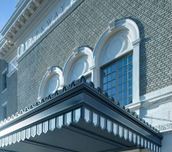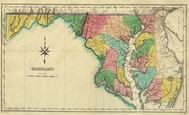 2019 Maryland Sustainable Growth Awards
Nominations are now being accepted for the 2019 Maryland Sustainable Growth Awards. Categories include: Leadership and Service; Sustainable Communities; and Preservation/Conservation. Nominate deserving people and projects to receive recognition at the 7th annual Sustainable Growth Awards Ceremony in 2019. Apply at https://bit.ly/2yvCDZU.
|
 Take Our Survey!
Thanks to everyone who came out to the regional public meetings for the statewide preservation plan! We've received great feedback so far. There's still time to register your thoughts by taking our online survey, available here: http://mht.maryland.gov/plan.shtml
|
Introducing the Architectural Survey Data Analysis Project
By Barbara Fisher, Architectural Survey Data Analyst
MHT has
begun a multi-year Architectural Survey Data Analysis
Project that will assess, county
by county, the Maryland
Inventory of Historic Properties (MIHP) and other MHT Library assets. This comprehensive review
will highlight documentation needs and inform and guide future MHT survey efforts
across the state. We anticipate that the project will identify underrepresented historic
themes, architectural styles, building and property types, as well as under-surveyed
areas of the state, sites that may
have become historic due to age and highly significant resources that
need to be resurveyed or researched further.
To
begin, MHT will analyze documentation found in our Library, such as
publications, compliance reports, historic structure reports, the MIHP survey
forms, National Register of Historic Places nominations, the slides and
negatives collections, architectural drawings, oral history projects, and
vertical files. Data collected during the project (e.g.
architectural style, building type, historic function, materials, date of
construction) will eventually become searchable data in Medusa,
our online cultural resources database. For example, a user will be able to
generate a list of all the frame Greek Revival style churches in the MIHP,
built during the 1850s, and organized by county.
Our project begins on Maryland’s Lower Eastern Shore with Worcester
County, characterized by its agricultural and maritime landscape. To give you a
sense of Worcester County’s architectural history, we have selected a few buildings
from the MIHP to share with you. The examples below illustrate a typical farmstead,
maritime tourism, and the business those economies produced.
Stockton Bank (WO-49), Stockton, 1969 - Note the word “BANK” on the west side of the slate hipped roof spelled in a lighter color slate.
Formerly located in the village of Stockton, Stockton
Bank, a one-story, brick building, accented with rusticated stone trim,
round-arched windows, metal cornice, and slate roof with metal cresting, was
constructed in 1902. Although Stockton Bank was demolished in 1983, similar banks are found
in other parts of the County, such as in Girdletree and Newark. These small-town,
bank-designed buildings emerged in Worcester County around the early 20th-century
due to the success of the local agricultural and seafaring economies at that
time. Please note: MHT retains documentation on demolished historic buildings as part of the MIHP, and known demolitions are flagged in Medusa.
Mansion House (WO-36), Public Landing, 1991
Located at Public Landing, the Mansion
House, listed in the National Register of Historic
Places, is a vernacular 19th-century “telescope” frame house
constructed in two stages. Public Landing developed into a bayside resort in
the late 19th-century and included a pier, boardwalk, and
concessions. Originally constructed as a home for Judge Ara Spence, the Mansion
House later served as a hotel to the resort where visitors could stay before
traveling to the nearby barrier islands. However, during the 1933 Nor’easter,
most of the resort was swept into Chincoteague Bay, except for the Mansion
House and some of the surrounding cottages.
Pennington Farm (WO-470), Gambrel Roof Barn, Garage, Shed, and Corn Crib, Berlin, 1995
Located just
north of Berlin, east of Route 113, the 42-acre Pennington
Farm property consists of a typical bungalow dwelling constructed in 1935
and nine associated outbuildings. The outbuildings include a chicken house,
gambrel roof barn, various sheds, a corn crib, two garages, and a horse corral.
As evidenced by the various outbuildings, Pennington Farm participated in
raising livestock, specifically chickens, and mixed crop-cultivation, common
agricultural trends associated with Worcester County's past.
During the course of the Architectural Survey Data Analysis Project, MHT
will share interesting properties and research findings from our MIHP records on
Facebook, so stay tuned for more as we move forward!

OUR HISTORY, OUR HERITAGE: BLOG ROUND-UP
|